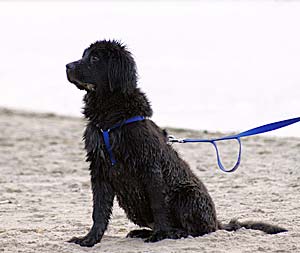Newfoundland

Register for a free My Pets account to feature you pet’s picture here!
- Dog Breed Group
- Working Dogs
- Origin of Breed
- Canada; Originally as a fisherman's dog, now a family pet
- Life Expectancy
- 10 Years
- Color
- Chocolate, Black, Bi-Color
- Coat
- Flat, dense, and coarse textured double coat; oily and water resistant. Outer coat moderately long, straight or slightly wavy.
- Exercise Needs
- They needs regular, moderate exercise even though he would love to laze around. Loves to swim they should be given the opportuni
- Temperament
- Responsive, docile.
- Good with Children
- Good with small children, provides a wonderful companion for growing active children. Good with other pets.
- Grooming Needs
- Daily brushing of his tick double coat with a hard brush. Shedding of the undercoat is twice a year. Avoid bathing unless necess
- Average Size - Male (in)
- 28
- Average Size - Female (in)
- 26
- Average Weight - Male (lbs)
- 130 - 150
- Average Weight - Female (lbs)
- 100 - 120
- Health Issues
- Hip dysplasia, genetic heart conditions.v
- Living Conditions
- Not suited for apartment living as they need lots of room. A large fenced yard is essential. They are more suited to colder than
Breed Description
The Newfoundland is a breed of working dog developed in Newfoundland, possibly from crosses between native dogs and the Great Pyrenees dogs taken to North America by Basque fishermen in the 17th century. The most likely theory of the origin of the Newfoundland is that it is a descendant of the Tibetan Mastiff. It developed webbed feet and oily coat in an effort to adapt to the rugged conditions in Newfoundland, Eastern Canada. The breed aided fishermen and gained great fame as a life-saver. It has strong instinct to rescue anything or anyone, in the water and retrieve it to safety. The Newfoundland is a huge, characteristically gentle and patient dog. It has powerful hindquarters, a large lung capacity, large webbed feet, and a heavy, oily coat contribute to the dog's ability to swim and to withstand cold waters. In addition to rescue work, the Newfoundland has served as a watchdog and companion and as a draft animal. The typical Newfoundland is solid black; the Landseer Newfoundland, named after Sir Edwin Landseer, the artist who painted it, is usually black and white.
Breed Infobits
The Newfoundland is the namesake of the Canadian island where it evolved.
Disclaimer: Pets.ca cannot be responsible for the accuracy of the above presented information. Please double check all information prior to making any decisions about purchasing this or any breed. If you think we have made an error with some of the information presented here, please e-mail us at breedprofiles@pets.ca.





